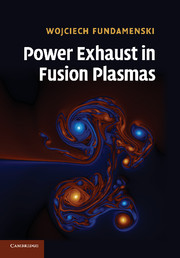Book contents
- Frontmatter
- Contents
- Preface
- 1 Introduction
- 2 Magnetized plasma physics
- 3 Magnetized plasma equilibrium
- 4 Magnetized plasma stability
- 5 Collisional transport in magnetized plasmas
- 6 Turbulent transport in magnetized plasmas
- 7 Tokamak plasma boundary and power exhaust
- 8 Outlook: power exhaust in fusion reactors
- Appendix A Maxwellian distribution
- Appendix B Curvilinear co-ordinates
- References
- Index
- Frontmatter
- Contents
- Preface
- 1 Introduction
- 2 Magnetized plasma physics
- 3 Magnetized plasma equilibrium
- 4 Magnetized plasma stability
- 5 Collisional transport in magnetized plasmas
- 6 Turbulent transport in magnetized plasmas
- 7 Tokamak plasma boundary and power exhaust
- 8 Outlook: power exhaust in fusion reactors
- Appendix A Maxwellian distribution
- Appendix B Curvilinear co-ordinates
- References
- Index
Summary
Power exhaust, by which we mean the safe removal of power from a burning plasma, is an essential requirement for the successful operation of any fusion reactor. Specifically, plasma thermal energy must be conveyed across the first wall without undue damage to plasma facing components (divertor and limiter tiles) by heat load related plasma–surface interactions (ablation, melting, erosion). Unlike other ‘technological’ problems related to fusion reactor design, e.g. tritium retention in plasma facing materials, neutron damage to structural components or non-inductive current drive, power exhaust is intimately linked to plasma confinement and thus a perennial concern for any fusion reactor. While only a minor issue in existing tokamaks, it will be critical for ITER (the next step plasma-burning experiment) and even more so for DEMO (the demonstration fusion power plant). Even non-burning, superconducting machines, such as EAST, KSTAR, JT60-SA, W7-X, etc. will be forced to tackle this problem due to their long pulse capabilities.
This monograph is an attempt to draw a unified and up-to-date picture of power exhaust in fusion plasmas, focusing primarily on the leading tokamak concept. Emphasis is placed on rigorous theoretical development, supplemented by numerical simulations when appropriate, which are then employed to explain and model a range of experimental observations. The objective is not just to provide the reader with a reliable map of the conquered territory and a guided tour over its many hills and valleys, but also to supply him or her with the tools necessary to embark on independent, and hopefully fruitful, journeys into the uncharted regions, the white spaces on the map, la terra incognita.
- Type
- Chapter
- Information
- Power Exhaust in Fusion Plasmas , pp. xi - xiiPublisher: Cambridge University PressPrint publication year: 2009

